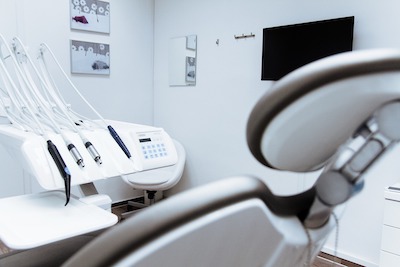What Are Dental Inlays and Onlays?
Over time, dentists have discovered many ways to restore a tooth to its proper function, even if it has suffered from decay and cavities. Dental inlays and onlays are used to restore the pit and the cusps of your teeth, also known as the part of your teeth you use to chew your food. This method is used when the decay has been treated before it’s worsened to the point of requiring a dental crown.
What Are Dental Inlays and Onlays? When a premolar or a molar tooth has received damage to the area used for chewing, the decay will be covered by a cap known as an inlay or an onlay. These differ from a dental crown in that they are only covering a portion of the tooth. The inlays will cover decay specifically affecting the pit of the tooth while an onlay can cover decay affecting the pit and a cusp of the tooth.
Dental inlays and onlays can restore the tooth to its proper function while also protecting from further decay. This is one of the many restorative dental services we offer at our Rogersville dentist office. To know more about inlays and onlays, keep reading.
When Do You Need a Dental Inlay Or Onlay
You will need a dental inlay/onlay if the chewing part of your tooth has experienced decay. These procedures will be used if only a portion of your tooth has decayed. If you’re in need of dental inlays/onlays, your teeth have experienced more decay than a simple filling can fix; however, they haven’t experienced enough decay that you would need a dental crown.
Inlays and onlays help to protect your tooth from further decay. The dentist will drill out any bacteria or decay in the tooth and then cover it with an inlay/onlay cap. These caps keep bacteria from getting down into the susceptible part of the tooth that has already experienced decay.
This procedure will also return your teeth to their proper function. Before, the decay in your tooth may have made chewing and eating too painful. Now, with an inlay or onlay coving the decay and protecting your tooth, you’ll be able to chew without pain.
Dental inlays and onlays fall under the restorative dentistry umbrella, as they help to restore the tooth to its proper function. This specific procedure caters to teeth with moderate decay or cavities; however, only a small amount of the tooth is removed to fit the product in place.
What is the Difference Between a Dental Inlay and a Dental Onlay?
Dental inlays and onlays differ from each other in that they are used to cover different areas of the tooth. A dental inlay specifically protects the pit of the tooth, also known as the middle part of the tooth that dips down and looks like a valley between the two cusps.
A dental onlay covers a larger surface area of the tooth. Onlays can cover both the pit of the tooth and the cusp of the tooth. Depending on how back the tooth decay is and where the decay is located will dictate whether you need an inlay or an onlay.
At our Rogersville dentist office, our doctors will be able to direct you in which procedure will best serve your particular case. They will keep you informed and fill you in on the specifics of the procedure.
How Are Dental Inlays & Onlays Installed
Dental inlays/onlays will be made outside of your mouth, then placed over the affected area and bonded to the original tooth. First, the dentist will drill out the decay in your tooth. Next, the inlay/onlay will be placed in the area of the tooth that has been removed. The dentist will bond the inlay to the tooth to help restore the integrity of the tooth’s structure.
The inlay/onlay procedure usually consists of two visits to the dentist. At your first visit, the dentist will gather the information needed in order to make the inlays or onlays. The dentist will take an impression of your tooth so that they can figure out how to construct the cap.
At your first visit, you’ll have temporary inlays put on your teeth until your next visit. When you come back to the dentist, they’ll have the permanent inlays/onlays ready and will install them and get them bonded to your teeth.
What Materials Are Used For Dental Inlays & Onlays
There are a number of different materials that can be used to make dental inlays or onlays. One of the benefits of these procedures is that the material used for the inlays usually blend with the look of your natural teeth.
Many dental inlays or onlays are made out of gold, porcelain, or dental composite. Some of these materials will give the products a natural look. While dental inlays can barely be noticed to an untrained eye, a regular filling of gold or silver can make the condition of your oral health obvious.
Talk to our Rogersville dentist to see what material would work best for your dental onlays. Materials differ in price and insurance coverage, so it’s important to choose the material that caters to you and your specific situation.
Alternative Options to Dental Inlays & Onlays
Alternative options to dental inlays and onlays are crowns or composite fillings; although, each of these procedures is created to treat a different amount of tooth decay that’s affecting the tooth.
A composite filling is a procedure used to correct minor tooth decay. These fillings are made from a resin material that will naturally blend with the tooth. The minor decay will be removed and the composite material will be added into the area of the tooth that was removed.
Fillings can be made from a number of different materials, but the composite filling is the option that will best blend with your natural teeth. Your dentist will use a shade guide to determine what color resin needs to be used to make the fillings unnoticeable.
Dental crowns are used to treat more extensive tooth decay. Much of the tooth’s surface area will have to be removed so that the crown can be placed over the tooth. Crowns can be made from a range of material, from porcelain to silver. You can choose a material that best blends with your teeth.
Inlays and onlays only cover a portion of the tooth. They act as both a filling and a crown in that the product fills the area of the tooth that was removed and it covers and bonds to the tooth to protect from bacteria.
The option you’ll need will largely depend on the amount of decay that your tooth has experienced.
Does Getting a Dental Inlay Hurt?
The dental inlay/onlay procedure will require an injection of anesthetic into your gums near the tooth that will be worked on. Once you have received the anesthetic, the dentist will drill the decay from your tooth. This portion of the procedure will be the most painful, although bearable with the use of anesthetic.
If your teeth require a dental inlay or onlay but you’re nervous about the pain you may experience, research sedation dentistry in your area. With sedation dentistry, the patient will be sedated for the procedure to help deal with the nerves and the pain. This practice is harmless and becoming more and more popular in America.
If you’re worried about the pain you might experience from a dental procedure, it always helps to remember that the dentist is trying to help you! This procedure is being done to help restore your teeth so you’re not in pain and so they can function as they should. Hopefully, this thought will help to calm some of the fears you’re feeling.
More Questions About Dental Inlays & Onlays:
How Long Do Inlays and Onlays Last?
One reason dental inlays and onlays are so effective is that they last a very long time! Dental inlays/onlays can last between 10-15 years if you take care of your teeth properly. You should continue to regularly brush and floss your teeth as well as attend regular dental exams.
Can Inlays and Onlays Fall Off?
Over time, your dental inlay or onlay can fall off. If this happens, it’s important to schedule a visit with your dentist as soon as possible to get the product replaced. Bacteria can easily find its way back into the affected area of your tooth and cause pain and more decay.
We hope this article was helpful to you and answered your questions about dental inlays and onlays. To read more about the procedure, you can visit our Dental inlays and onlays service page.








